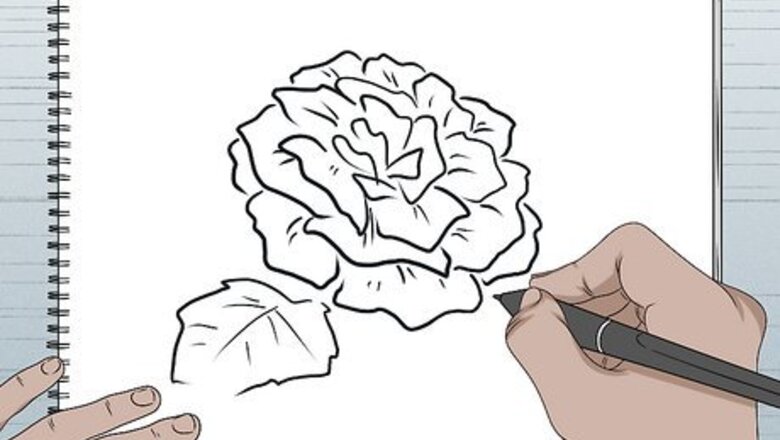
views
Draw a flower.
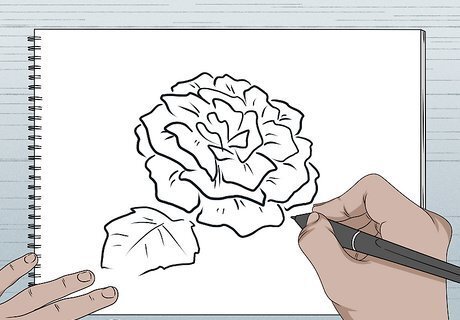
Fill up a page with the blooms that you sketch. Flowers are a fun and versatile drawing subject because they're so varied in shape, size, and color. Pick your favorite flower to sketch, and focus on lightly outlining its basic shape before adding in petals and further detail. Don’t be afraid to use a reference—it will help you become a better artist! If you have a garden, you could go outside and draw the first flower you see. Otherwise, you could look up a picture of the flower you want to draw online. For example, you can easily draw a rose in bloom by drawing its center as a small circle and then layering petals in irregular rows around it. If flowers aren't your style, draw a pinecone instead. Draw the pinecone's teardrop shape first and fill in its overlapping scales.
Sketch a fantasy creature.
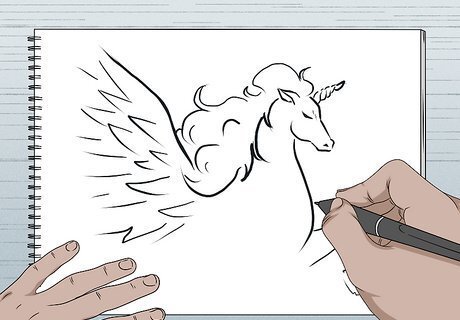
Try a dragon, unicorn, or sea monster if you're a fan of the fantastical. This is similar to drawing a regular animal—it just requires a little more imagination! Outline a dragon's reptilian head, body, and joints before sketching the details. Draw a unicorn the same way you'd draw a horse before adding a horn. Start with a scaly, serpentine body if you want to draw a simple sea monster. You could also create your own mythological creature if you're ready to flex your imagination.
Practice basic shapes.
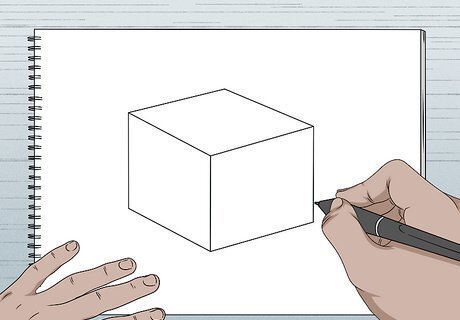
Master spheres and cubes before moving to more complex subjects. For spheres, you can make a light rough outline with your pencil, sketching quickly as you capture the overall shape. Cubes are a little easier to sketch since they're all straight lines; draw two overlapping squares of the same size and connect their corners to make your cube. Try drawing other 3D shapes, like cones, pyramids, and prisms. This will help you develop your skill in creating 3D objects on 2D paper.
Sketch a tree outside your window.
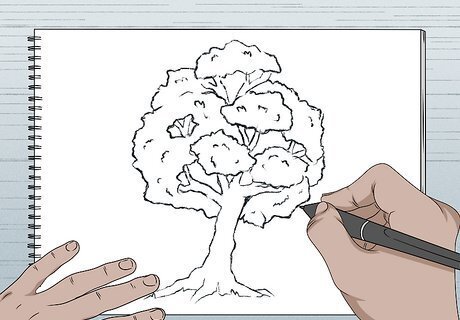
Study the tree's branches and overall shape to capture it in detail. Each tree has its own way of branching, so start by looking at its basic shapes and then filling it in from there. Once you've got the trunk and head of the tree outlined, fill in branches where you see them. Add in sky holes last—breaks in the leafy tree canopy where you can see the sky. Think of leaves as masses, especially if you're studying the tree from afar. Don't outline every leaf; instead, add the most detail where leaves meet the sky, as that is where you can see their shape most clearly.
Doodle a cool animal.
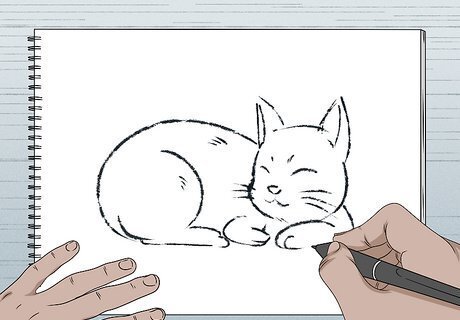
Pick your favorite animal and try either a realistic or cartoon style. If you're looking for less of a challenge, stick to a simple cartoon; you can easily create an animal cartoon by drawing a base shape and then filling in the details. If you're drawing a lifelike picture of the animal, start by marking its joints and creating circles for the head, body, and limbs before outlining the animal and adding detail. Use your pet as inspiration. You could draw a dog, rabbit, cat, bird, or any other animal you might own. If you like big cats, try drawing a jaguar. If you find marine life fascinating, draw a shark, dolphin, or another colorful fish that catches your eye.
Create a hybrid animal.
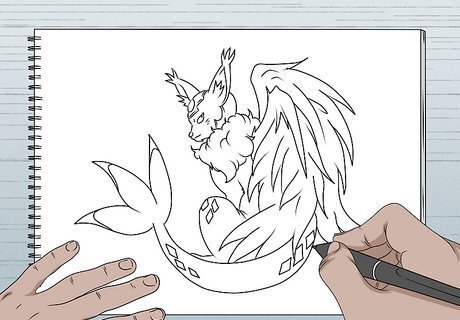
Get creative by combining different animal features into one drawing. If you're looking to go beyond realistic drawings, use your imagination to craft an animal of your own design. Pick two or three regular animals you'd like to combine and study each animal to find which aspects you want to incorporate in your sketch. Then, outline your animal and add detail to the drawing.
Draw a portrait.
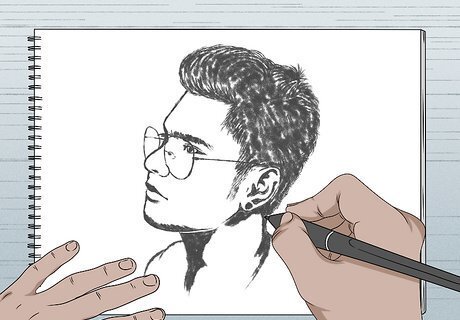
Practice your facial drawing skills if you can spare a couple of hours. Portraits typically take a bit longer if you're aiming for detail and realism, but practicing your portrait-drawing skills helps you become a better artist. Pick a reference photo and plan out the head: draw its general shape, then create lines to place the eyes, nose, and mouth. Once everything is mapped out, sketch the face. Make sure you choose a picture where the person in question is eye-level with the photographer. That way, you won't be trying to draw at an odd angle.
Sketch a favorite cartoon character.
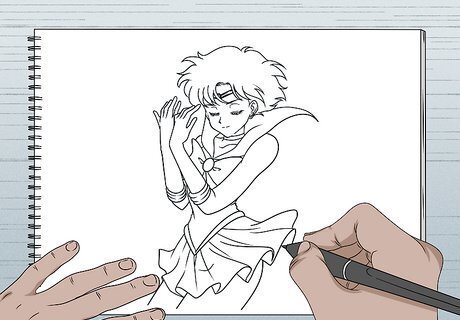
Put your own spin on a character that makes you smile. From SpongeBob SquarePants to Mickey Mouse, decide which cartoon character to draw. Make sure you have a reference on hand if you haven't drawn them before, and refer to it regularly to ensure your sketch is accurate. Block out the sketch first and draw all the major shapes before adding details like clothes, fur, facial features, etc. If you're a fan of How to Train Your Dragon, you could try drawing Toothless. If you like Peanuts, you could always draw Snoopy.
Create a character from your imagination.

If you have original characters, drawing can help you flesh them out. Whether you like to write stories or play roleplaying games, you've probably dreamt up more than a few original characters. Pick a distinctive posture and style before sketching the character, and finalize your character once you've drawn a few different sketches to pick the one you like best. It's helpful to have a character concept before you start drawing, including a short description of their physical appearance and role in your story.
Draw a landscape.
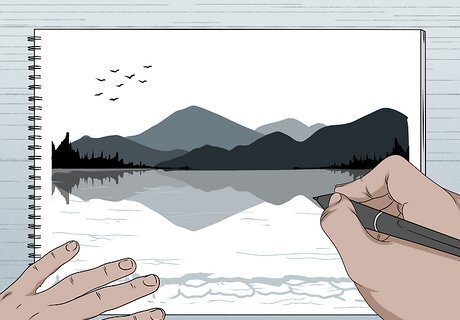
Find a photo on your phone or look out the window for inspiration. Once you have your reference for the drawing, start off by blocking out the biggest shapes in the landscape. Then, refine it with contour lines and smaller elements—like rocks and plants in the background. Finally, capture the landscape’s details, like blades of grass and texture on trees and rocks. To ensure accuracy, consider using a grid. Draw grid lines over your reference photo and the same-proportion grid lines over your drawing paper. You'll have a more detailed guide as you sketch your landscape.
Do a blind contour drawing.

Sketch while keeping your eyes on the subject, not your drawing. A blind contour drawing is a simple exercise with two main rules. First, you need to pick a subject and draw it without looking at your paper. Second, once your pencil touches the paper, you can't lift it again. This will help you improve your skills and train your eyes to work in tandem with your hand. Observation is one of the biggest components of a successful drawing. If you're looking to become the best artist you can be, observing your subject matter carefully is key.
Sketch people on the street.

Sketching interesting individuals is a great way to get better at drawing. Spy on people in the park to try and draw them as they talk, eat or sunbathe. Go to a cafe and people-watch, sketching those who come in for a coffee. Observing people and completing quick sketches of them gets you comfortable drawing humans of all shapes and sizes—and it's fun! Find a comfortable place to sit in a public area and do your best to look inconspicuous; wear earbuds and sit with your back to the wall if you don't want anyone to see you sketching.
Recreate a work of art.
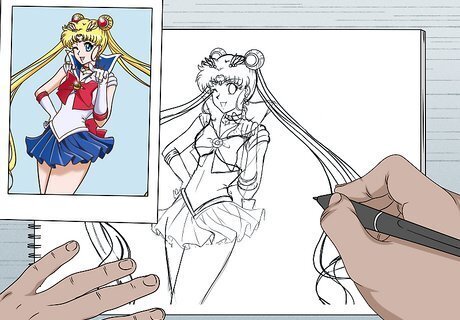
Pick a piece you love and draw it to learn how it was made. Print out the piece you want to draw and recreate it using the visual reference, or use tracing paper and a pencil to go over the printout and make your drawing. This will help you understand different approaches to drawing and improve your own skills simultaneously. Whether you're a novice or seasoned artist, you probably have a few artistic role models. You can recreate art from any era, whether it's a da Vinci or your favorite character artist on Instagram.
Practice drawing in perspective.
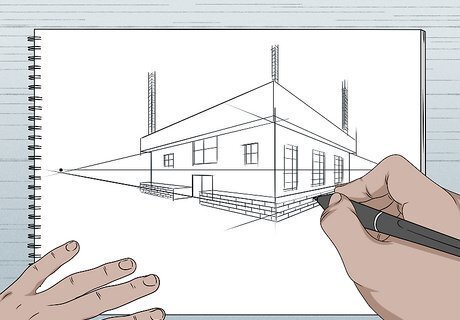
Hone your technical skills by drawing three-dimensional buildings. Using a two-point perspective can create accurate drawings with depth. First, draw a straight horizon line, and place dots called vanishing points at either end of the line. Then, as you draw your building, use a ruler to ensure that any parallel receding lines of the building follow back to one of the vanishing points. If it helps you create an accurate building, you can trace receding lines back to a vanishing point and then erase them later. Vanishing points don't have to be placed on your page. It's helpful to do so if you're just starting out, but vanishing points are often located at imaginary spots further back from the page.




















Comments
0 comment